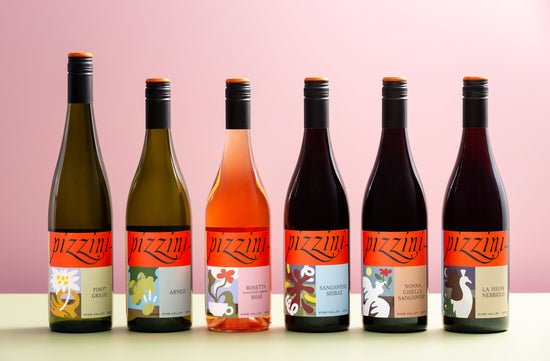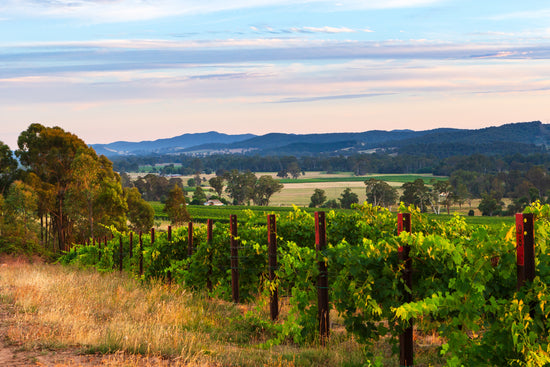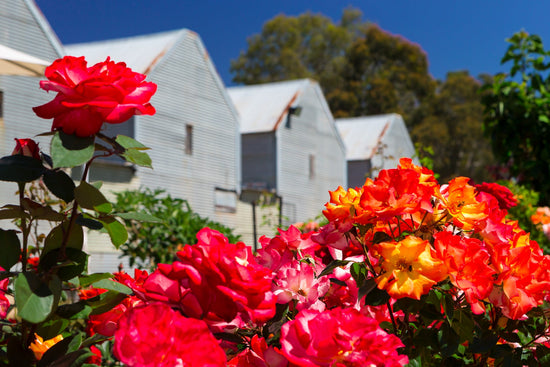After more than thirty years of growing grapes, the Pizzini family had noticed that the same grape variety, when planted in different areas of the property, performed entirely differently. Joel Pizzini, the chief winemaker, gives the example of one of the early sangiovese plantings. No matter what they did in the vineyard, the fruit didn’t express the concentration and quality they needed to make a red wine. It did, however, have beautifully floral characters that perfectly suited their pretty, yet savoury, rosé. Less than one kilometre away, on the rolling hills that overlook the cellar door, the sangiovese easily achieved the deep red fruit characters, bright acidity and levels of fine, yet firm tannins that allowed them to make a great sangiovese every year. “It made me think about how we were operating as a whole and how we could design our range around what our sites can naturally produce,” Joel says. This prompted the idea to develop the Strength of Site range, to express the individuality of some of the special sites the family had access to.
“Prior to 2013 we just had ‘Pizzini Sangiovese,’” Joel explains. For the Strength of Site range, “We wanted to give names that gave meaning to where the grapes were selected from.” The blocks identified as consistently producing high-quality fruit, have iron-rich soil, the colour of rust and volcanic in origin. This helped the Pizzinis arrive at the name ‘Forza di Ferro’, Italian for ‘Strength from Iron.’ Joel describes this wine as “the essence of sangiovese,” and the winemaking aims to preserve that. Once picked, the grapes are crushed, destemmed and allowed to rest at cool temperatures for 4-5 days to encourage a gentle extraction of colour and flavour. Fermentation begins with wild yeast, adding complexity. Once fermentation is complete, a small portion of the wine spends time in a special tulip-shaped cement tank, to retain freshness and allow the floral character of sangiovese to remain. The remainder ages in older oak barrels, primarily large barrels where “the flavours of the wine when it goes in, are basically the same as when it comes out. But the tannins benefit from that slow ageing process,” Joel says.
L’Aqulia is “the eagle”, named for the sites that have exemplified premium Nebbiolo – high up on the ridges overlooking where the original Pizzini property lies. Fruit is hand-harvested to protect the delicate fruit from oxidation. The grapes are crushed, destemmed and a strain of yeast from Barolo (the iconic Nebbiolo-producing region of Italy) is added to start fermentation. Nebbiolo is handled gently in the winery to avoid over-extraction of its trademark powerful tannins. The wine finishes fermentation in large, old oak barrels to allow polymerisation; a process by which small, astringent tannins group together to form large, smoother tannin molecules. Nebbiolo needs time to develop its ethereal floral and fruit characters, balanced with the savoury, structured tannins. To allow for this, and to ensure the wine is ready to drink when released, it is aged in large barrels for two years and then in bottle for around another two years to allow it to transform. Joel believes that “when we release a new wine, we have a responsibility to provide a good experience right from the first taste.”
Il Barone, meaning ‘The Barone,’ is a wine that represents the Pizzini winemaking story. It starts with shiraz and cabernet sauvignon, the grape varieties that began Pizzini Wines with their first commercial release in 1994. Sangiovese joins in to show the Italian flair and then Nebbiolo adds length and complexity. Joel describes this wine as “a master blend.” Each variety is fermented and aged separately before being blended together to produce a wine that is greater than the sum of its parts. Joel explains that it is all about achieving the perfect balance. He starts with selecting the cabernet sauvignon portion, “to form the shell of, and structure of the of the wine.” Shiraz is added next for its riper, juicy fruit, peppery spice and rounded tannins. Sangiovese contributes a tangy red cherry lift and a beautiful savouriness. Nebbiolo joins in last “to draw it all together and add length and line.
The inspiration for Il Barone was to showcase, what we believe, are the great red wine grape varieties of the world. The first releases of this wine included fruit entirely from the Pizzini Estate. However, as part of our move towards specialising in Italian varieties, the plantings of Cabernet Sauvignon on the Pizzini property were grafted to Pinot Grigio, which performs better on our site. The Cabernet Sauvignon is now sourced from a premium Cabernet Sauvignon vineyard in the King Valley. The north-facing, low-yielding site allows the fruit to achieve optimal ripeness and consistently delivers the richness and structure fitting for the backbone of Il Barone.
The strength of site range is a tribute to the remarkable plots of land woven into the Australian history of the Pizzini family. Their passion for understanding the land is an important part of this chapter of their story. And the wines are a unique opportunity to taste history in the making.





